Citroen C4 AIRCROSS RHD 2014 1.G Owner's Manual
Manufacturer: CITROEN, Model Year: 2014, Model line: C4 AIRCROSS RHD, Model: Citroen C4 AIRCROSS RHD 2014 1.GPages: 368, PDF Size: 20.32 MB
Page 171 of 368
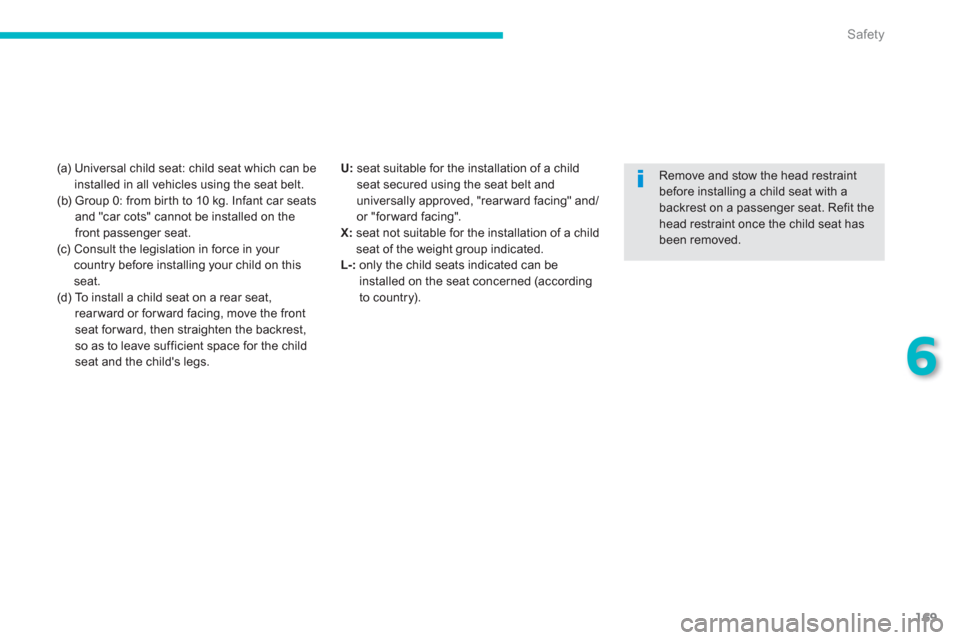
169
6
Safety
(a) Universal child seat: child seat which can be
installed in all vehicles using the seat belt.
(b) Group 0: from birth to 10 kg. Infant car seats
and "car cots" cannot be installed on the
front passenger seat.
(c) Consult the legislation in force in your
country before installing your child on this
seat.
(d) To install a child seat on a rear seat,
rear ward or for ward facing, move the front
seat for ward, then straighten the backrest,
so as to leave sufficient space for the child
seat and the child's legs.
Remove and stow the head restraint
before installing a child seat with a
backrest on a passenger seat. Refit the
head restraint once the child seat has
been removed.
U:
seat suitable for the installation of a child
seat secured using the seat belt and
universally approved, "rear ward facing" and/
or "forward facing".
X:
seat not suitable for the installation of a child
seat of the weight group indicated.
L-:
only the child seats indicated can be
installed on the seat concerned (according
to country).
Page 172 of 368
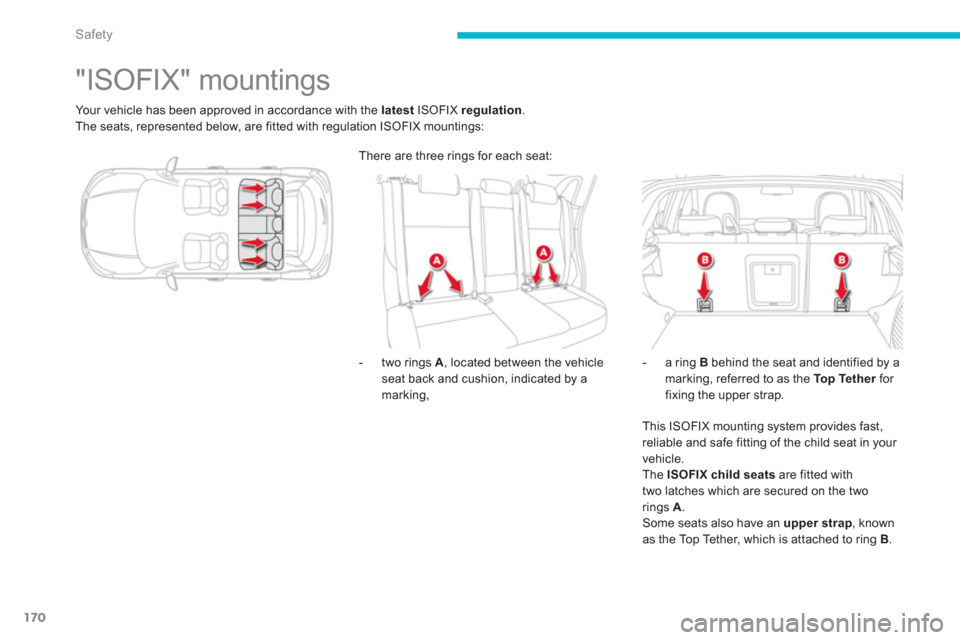
170
Safety
"ISOFIX" mountings
Your vehicle has been approved in accordance with the latest
ISOFIX regulation
.
The seats, represented below, are fitted with regulation ISOFIX mountings:
- two rings A
, located between the vehicle
seat back and cushion, indicated by a
marking,
- a ring B
behind the seat and identified by a
marking, referred to as the To p Te t h e r
for
fixing the upper strap.
This ISOFIX mounting system provides fast,
reliable and safe fitting of the child seat in your
vehicle.
The ISOFIX child seats
are fitted with
two latches which are secured on the two
rings A
.
Some seats also have an upper strap
, known
as the Top Tether, which is attached to ring B
. There are three rings for each seat:
Page 173 of 368
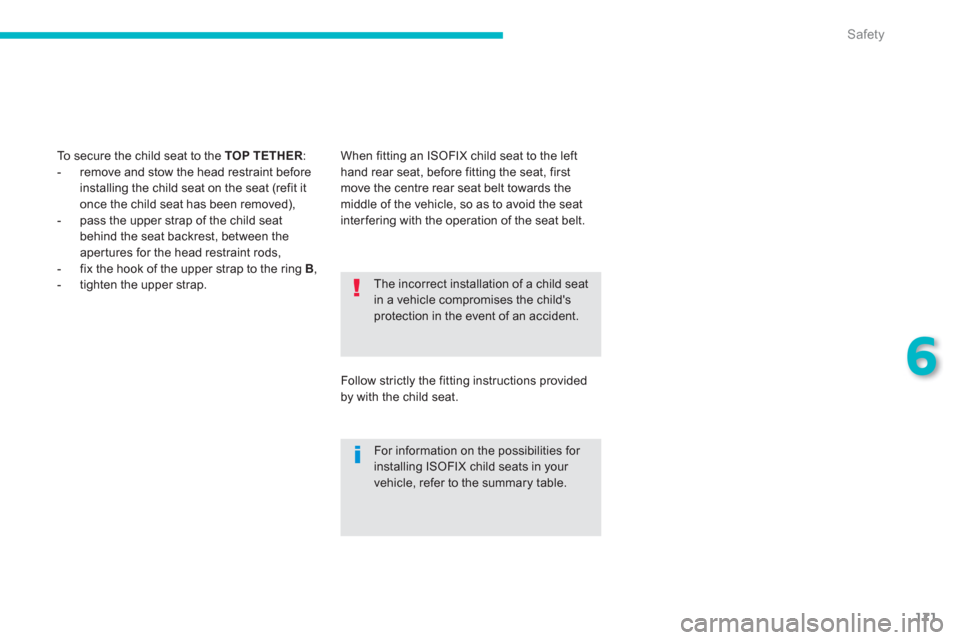
171
6
Safety
The incorrect installation of a child seat
in a vehicle compromises the child's
protection in the event of an accident.
For information on the possibilities for
installing ISOFIX child seats in your
vehicle, refer to the summary table. To secure the child seat to the TOP TETHER
:
- remove and stow the head restraint before
installing the child seat on the seat (refit it
once the child seat has been removed),
- pass the upper strap of the child seat
behind the seat backrest, between the
apertures for the head restraint rods,
- fix the hook of the upper strap to the ring B
,
- tighten the upper strap. When fitting an ISOFIX child seat to the left
hand rear seat, before fitting the seat, first
move the centre rear seat belt towards the
middle of the vehicle, so as to avoid the seat
inter fering with the operation of the seat belt.
Follow strictly the fitting instructions provided
by with the child seat.
Page 174 of 368
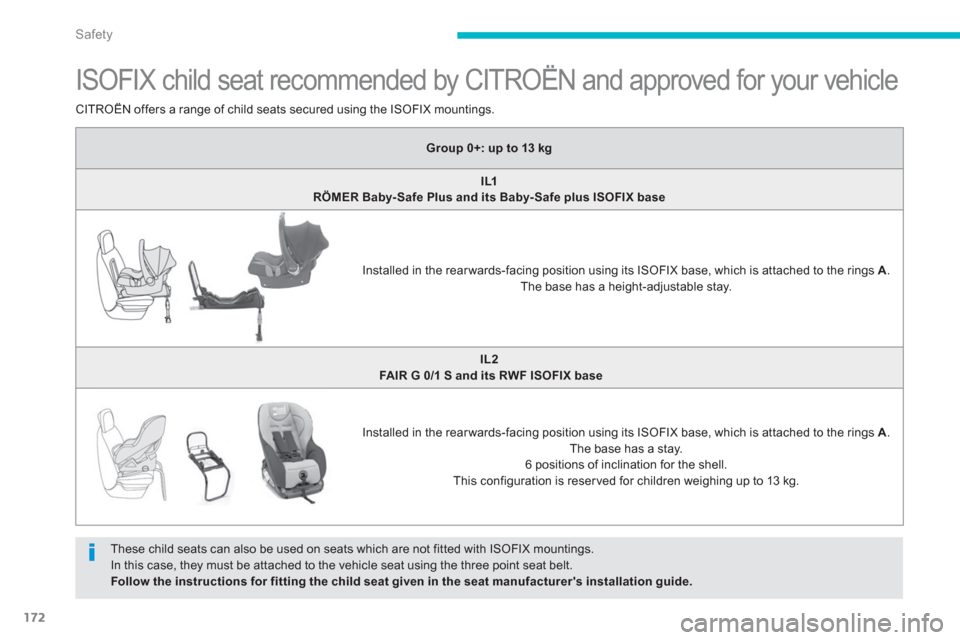
172
Safety
ISOFIX child seat recommended by CITROËN and approved for your vehicle
These child seats can also be used on seats which are not fitted with ISOFIX mountings.
In this case, they must be attached to the vehicle seat using the three point seat belt.
Follow the instructions for fitting the child seat given in the seat manufacturer's installation guide.
CITROËN offers a range of child seats secured using the ISOFIX mountings.
Group 0+: up to 13 kg
IL1
RÖMER Baby- Safe Plus and its Baby- Safe plus ISOFIX base
Installed in the rear wards-facing position using its ISOFIX base, which is attached to the rings A
.
The base has a height-adjustable stay.
IL2
FAIR G 0/1 S and its RWF ISOFIX base
Installed in the rear wards-facing position using its ISOFIX base, which is attached to the rings A
.
The base has a stay.
6 positions of inclination for the shell.
This configuration is reserved for children weighing up to 13 kg.
Page 175 of 368
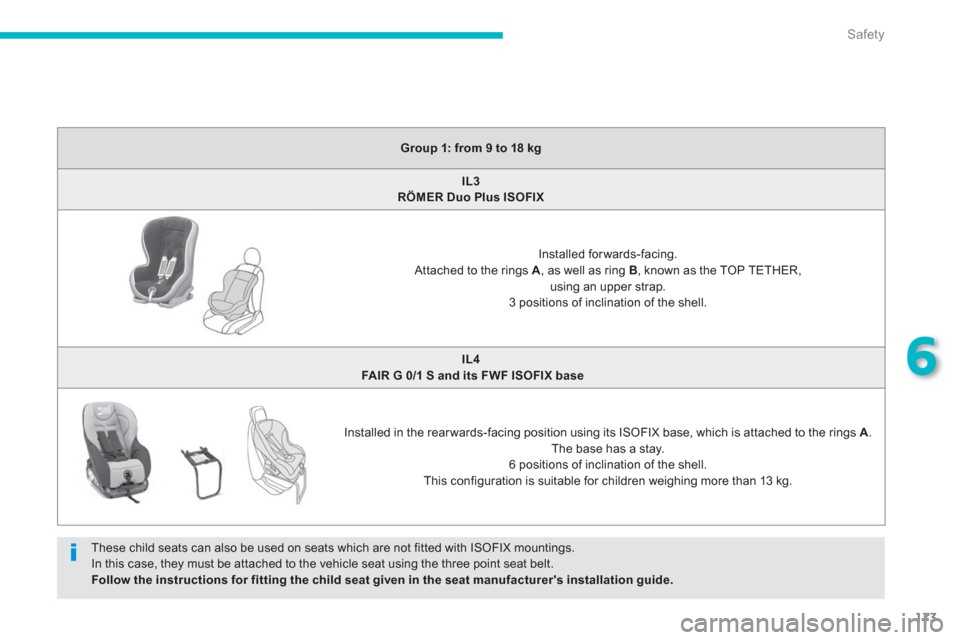
173
6
Safety
Group 1: from 9 to 18 kg
IL3
RÖMER Duo Plus ISOFIX
Installed forwards-facing.
Attached to the rings A
, as well as ring B
, known as the TOP TETHER,
using an upper strap.
3 positions of inclination of the shell.
IL4
FAIR G 0/1 S and its FWF ISOFIX
base
Installed in the rear wards-facing position using its ISOFIX base, which is attached to the rings A
.
The base has a stay.
6 positions of inclination of the shell.
This configuration is suitable for children weighing more than 13 kg.
These child seats can also be used on seats which are not fitted with ISOFIX mountings.
In this case, they must be attached to the vehicle seat using the three point seat belt.
Follow the instructions for fitting the child seat given in the seat manufacturer's installation guide.
Page 176 of 368
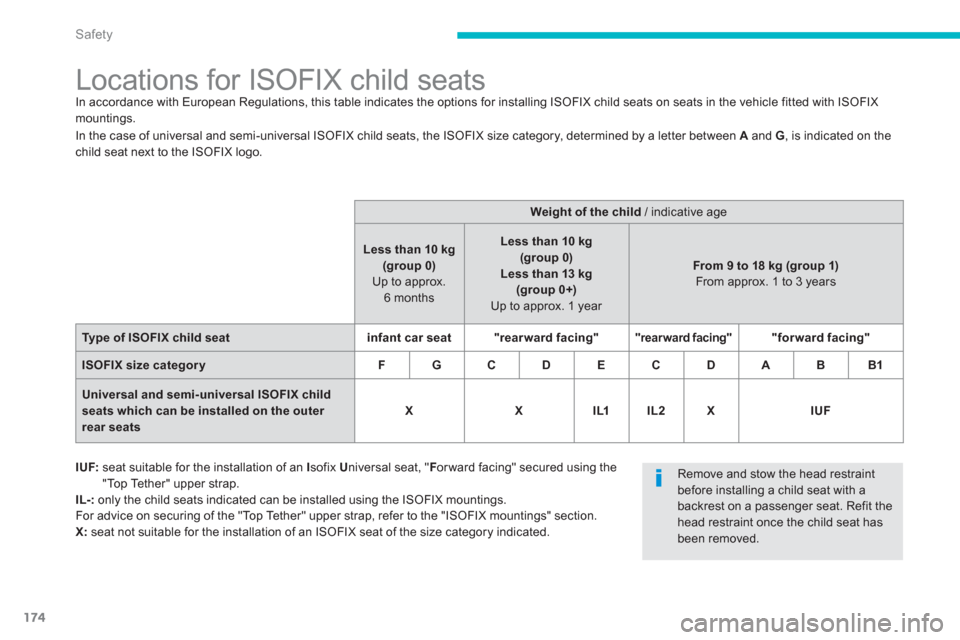
174
Safety
Locations for ISOFIX child seats
In accordance with European Regulations, this table indicates the options for installing ISOFIX child seats on seats in the vehicle fitted with ISOFIX
mountings.
In the case of universal and semi-universal ISOFIX child seats, the ISOFIX size category, determined by a letter between A
and G
, is indicated on the
child seat next to the ISOFIX logo.
Weight of the child
/ indicative age
Less than 10 kg
(group 0)
Up to approx.
6 months
Less than 10 kg
(group 0)
Less than
13 kg
(group 0+)
Up to approx. 1 year
From 9 to 18 kg (group 1)
From approx. 1 to 3 years
Type of ISOFIX child seat
infant car seat
"
rearward
facing"
"
rearward
facing"
"forward facing"
ISOFIX size category
F
G
C
D
E
C
D
A
B
B1
Universal and semi-universal ISOFIX child
seats which can be installed on the outer
rear seat
s
X
X
IL1
IL2
X
IUF
IUF:
seat suitable for the installation of an I
sofix U
niversal seat, " F
or ward facing" secured using the
"Top Tether" upper strap.
IL-:
only the child seats indicated can be installed using the ISOFIX mountings.
For advice on securing of the "Top Tether" upper strap, refer to the "ISOFIX mountings" section.
X:
seat not suitable for the installation of an ISOFIX seat of the size category indicated.
Remove and stow the head restraint
before installing a child seat with a
backrest on a passenger seat. Refit the
head restraint once the child seat has
been removed.
Page 177 of 368
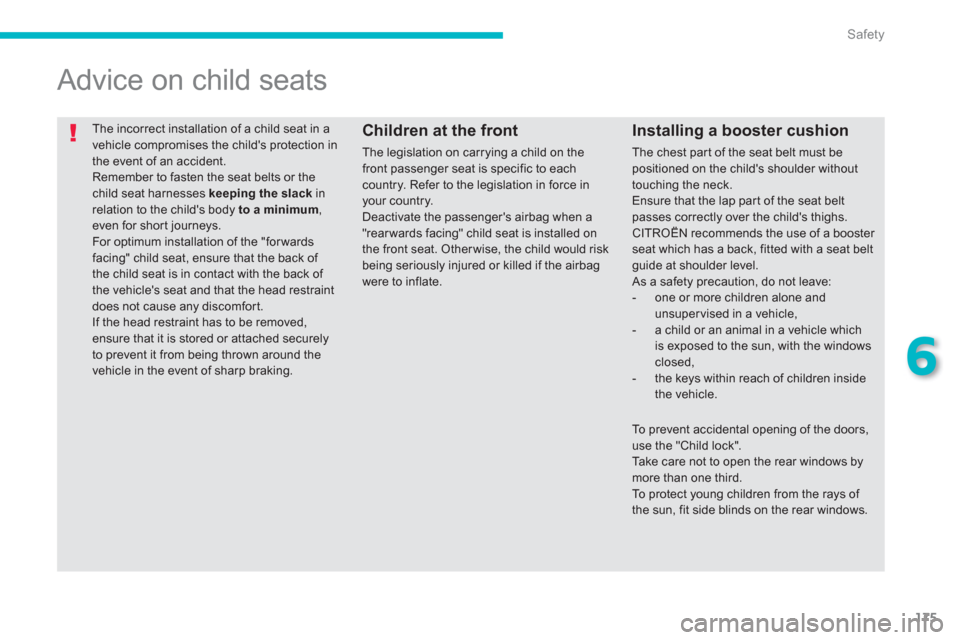
175
6
Safety
The incorrect installation of a child seat in a
vehicle compromises the child's protection in
the event of an accident.
Remember to fasten the seat belts or the
child seat harnesses keeping the slack
in
relation to the child's body to a minimum
,
even for short journeys.
For optimum installation of the "for wards
facing" child seat, ensure that the back of
the child seat is in contact with the back of
the vehicle's seat and that the head restraint
does not cause any discomfort.
If the head restraint has to be removed,
ensure that it is stored or attached securely
to prevent it from being thrown around the
vehicle in the event of sharp braking.
Advice on child seats
Installing a booster cushion
The chest part of the seat belt must be
positioned on the child's shoulder without
touching the neck.
Ensure that the lap part of the seat belt
passes correctly over the child's thighs.
CITROËN recommends the use of a booster
seat which has a back, fitted with a seat belt
guide at shoulder level.
As a safety precaution, do not leave:
- one or more children alone and
unsuper vised in a vehicle,
- a child or an animal in a vehicle which
is exposed to the sun, with the windows
closed,
- the keys within reach of children inside
the vehicle.
Children at the front
The legislation on carrying a child on the
front passenger seat is specific to each
country. Refer to the legislation in force in
your country.
Deactivate the passenger's airbag when a
"rear wards facing" child seat is installed on
the front seat. Other wise, the child would risk
being seriously injured or killed if the airbag
were to inflate.
To prevent accidental opening of the doors,
use the "Child lock".
Take care not to open the rear windows by
more than one third.
To protect young children from the rays of
the sun, fit side blinds on the rear windows.
Page 178 of 368
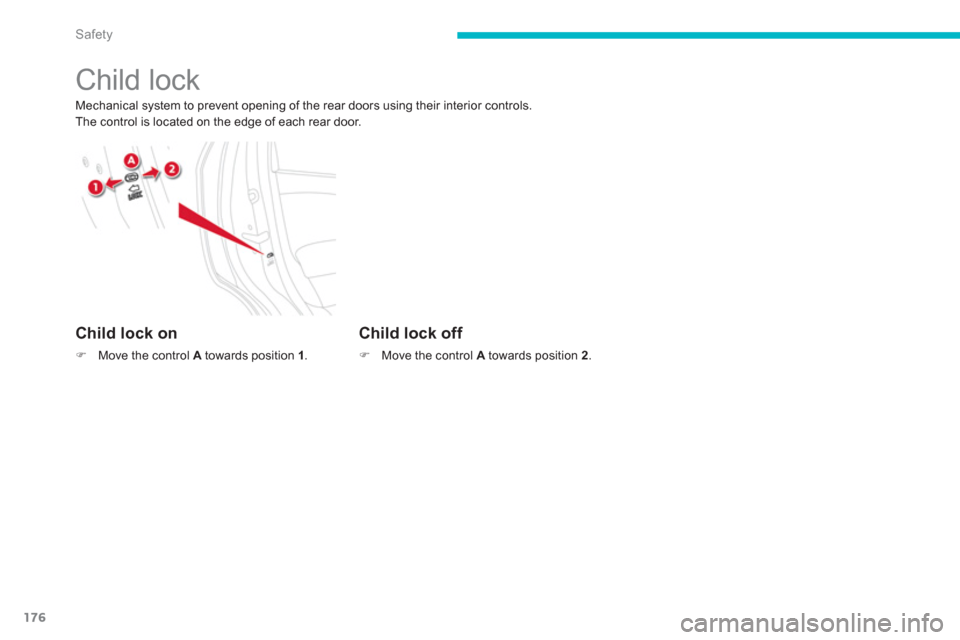
176
Safety
Child lock
Mechanical system to prevent opening of the rear doors using their interior controls.
The control is located on the edge of each rear door.
Child lock on
�)
Move the control A
towards position 1
.
Child lock off
�)
Move the control A
towards position 2
.
Page 179 of 368
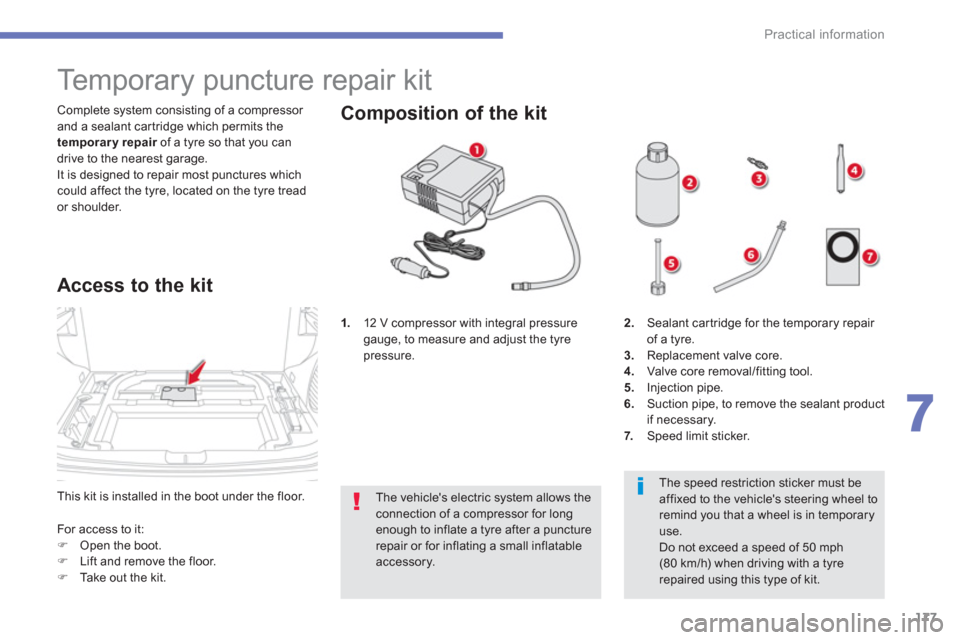
177
7
Practical information
This kit is installed in the boot under the floor. Complete system consisting of a compressor
and a sealant cartridge which permits the
temporary repair
of a tyre so that you can
drive to the nearest garage.
It is designed to repair most punctures which
could affect the tyre, located on the tyre tread
or shoulder.
Temporary puncture repair kit
Access to the kit
1.
12 V compressor with integral pressure
gauge, to measure and adjust the tyre
pressure.
For access to it:
�)
Open the boot.
�)
Lift and remove the floor.
�)
Take out the kit.
Composition of the kit
The speed restriction sticker must be
affixed to the vehicle's steering wheel to
remind you that a wheel is in temporary
use.
Do not exceed a speed of 50 mph
(80 km/h) when driving with a tyre
repaired using this type of kit.
2.
Sealant cartridge for the temporary repair
of a tyre.
3.
Replacement valve core.
4.
Valve core removal/fitting tool.
5.
Injection pipe.
6.
Suction pipe, to remove the sealant product
if necessary.
7.
Speed limit sticker.
The vehicle's electric system allows the
connection of a compressor for long
enough to inflate a tyre after a puncture
repair or for inflating a small inflatable
accessory.
Page 180 of 368
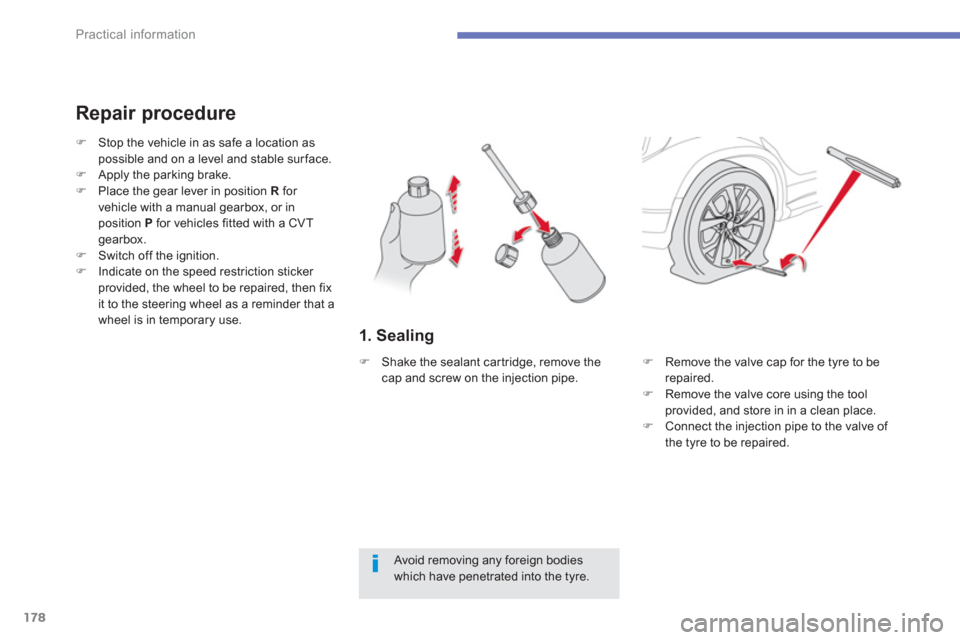
178
Practical information
1. Sealing
Repair procedure
Avoid removing any foreign bodies
which have penetrated into the tyre.
�)
Stop the vehicle in as safe a location as
possible and on a level and stable sur face.
�)
Apply the parking brake.
�)
Place the gear lever in position R
for
vehicle with a manual gearbox, or in
position P
for vehicles fitted with a CVT
gearbox.
�)
Switch off the ignition.
�)
Indicate on the speed restriction sticker
provided, the wheel to be repaired, then fix
it to the steering wheel as a reminder that a
wheel is in temporary use.
�)
Remove the valve cap for the tyre to be
repaired.
�)
Remove the valve core using the tool
provided, and store in in a clean place.
�)
Connect the injection pipe to the valve of
the tyre to be repaired.
�)
Shake the sealant cartridge, remove the
cap and screw on the injection pipe.